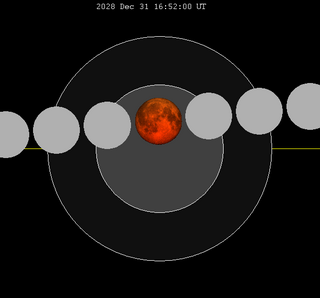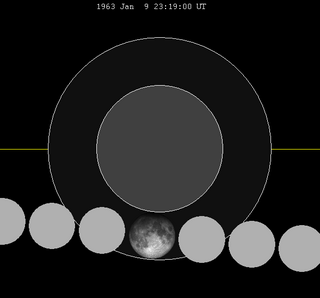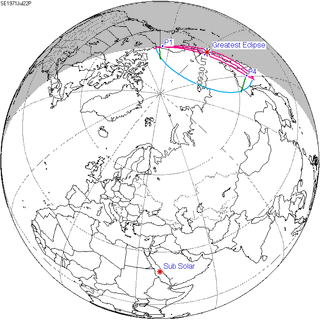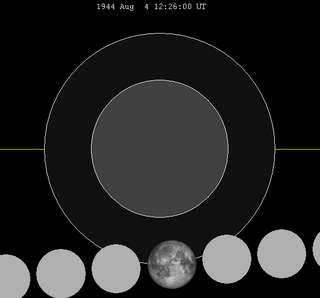
A penumbral lunar eclipse took place on Wednesday, February 9, 1944.

A penumbral lunar eclipse took place on Wednesday, February 9, 1944.
| Ascending node | Descending node | |||||
|---|---|---|---|---|---|---|
| Saros | Date Viewing | Type Chart | Saros | Date Viewing | Type Chart | |
| 102 | 1940 Mar 23  | Penumbral | 107 | |||
| 112 | 1941 Mar 13  | Partial | 117 | 1941 Sep 05  | Partial | |
| 122 | 1942 Mar 03  | Total | 127 | 1942 Aug 26  | Total | |
| 132 | 1943 Feb 20  | Partial | 137 | 1943 Aug 15  | Partial | |
| 142 | 1944 Feb 09  | Penumbral | 147 | 1944 Aug 04  | Penumbral | |

A lunar eclipse is an astronomical event that occurs when the Moon moves into the Earth's shadow, causing the Moon to be darkened. Such alignment occurs during an eclipse season, approximately every six months, during the full moon phase, when the Moon's orbital plane is closest to the plane of the Earth's orbit.

A total lunar eclipse will take place on Sunday, December 31, 2028. It will occur during a blue moon and is the first such eclipse to happen on New Year's Eve and New Year's Day since December 2009, and the first total lunar eclipse on New Year's Day in history. The next such eclipse will be on December 2047.

A penumbral lunar eclipse took place on Sunday, December 30, 2001, the last of three lunar eclipses in 2001.

A penumbral lunar eclipse took place on Sunday, January 31, 1999, the first of two lunar eclipses in 1999.

A total lunar eclipse will take place on May 26, 2040. The northern limb of the moon will pass through the center of the Earth's shadow. This is the second central lunar eclipse of Saros series 131.

A penumbral lunar eclipse took place on Wednesday, January 30, 1991, the first of four lunar eclipses in 1991.

A partial lunar eclipse occurred on the 16 and 17 July 2019. The Moon was covered 65.31% by the Earth's umbral shadow at maximum eclipse.
A penumbral lunar eclipse will take place on Monday, March 25, 2024. It will be visible to the naked eye as 95.57% of the Moon will be immersed in Earth's penumbral shadow.

A penumbral lunar eclipse will take place on May 7, 2031.

A penumbral lunar eclipse took place on Sunday, July 15, 1973, the third of four lunar eclipses in 1973, the first was a penumbral lunar eclipse on Thursday, January 18, the second was a penumbral lunar eclipse on Friday, June 15, and the last being with a partial lunar eclipse on Monday, December 10.

A partial lunar eclipse took place on Monday, June 14, 1965. At maximum eclipse, a small bite out of the Moon should have been visible. The eclipse lasted for 1 hour and 40 minutes, with just 18% of the Moon in shadow at maximum.

A penumbral lunar eclipse took place on Wednesday, January 9, 1963, the first of three lunar eclipses in 1963.

A partial lunar eclipse took place on Thursday, March 2, 1961, the first of two partial lunar eclipses in 1961.

A total lunar eclipse took place on Sunday, July 26, 1953.

A total lunar eclipse will take place on April 26, 2051.

A partial solar eclipse occurred on July 22, 1971. This was the 70th and final solar eclipse from Solar Saros 116.

A penumbral lunar eclipse took place on Thursday, July 6, 1944.

A penumbral lunar eclipse took place on Friday, December 29, 1944. In a rare total penumbral eclipse, the entire Moon was partially shaded by the Earth, and the shading across the Moon should have been quite visible at maximum eclipse. The penumbral phase lasted for 4 hours and 27 minutes in all, though for most of it, the eclipse was extremely difficult or impossible to see.

A penumbral lunar eclipse took place on Friday, August 4, 1944.